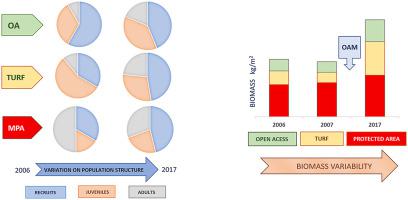Ocean & Coastal Management ( IF 4.8 ) Pub Date : 2021-07-13 , DOI: 10.1016/j.ocecoaman.2021.105811 Fernando González-Roca 1 , Stefan Gelcich 2, 3 , Ángel Pérez-Ruzafa 1 , J.M.Alonso Vega 4 , Julio A. Vásquez 5

|
Achieving sustainable use of kelps is key for small-scale fishers’ livelihoods and biodiversity. During the last three decades, Chile has implemented different policy approaches to manage kelps. Unfortunately, assessments of the biological impacts of these management regimes have not received the attention they deserve. In this study, we explore biomass, density, size structure and holdfast diameter/stipe length relation of the kelp Lessonia spp., associated to a territorial user rights policy, which grant exclusive access to fishers, and a regional management plan policy which defines control rules in what were historically de facto open access areas. We compare these with marine protected areas where harvesting is banned, thus serving as a benchmark. The study was performed along the coast of two of the main kelp harvesting regions of Chile. The analyses, performed in two time periods, shows that biomass is greater inside areas managed through territorial user rights and in marine protected areas compared to areas where regional management plans have been implemented, which perform in a similar way to open access sites. Enforcement is a key driver of kelp response. Densities of recruits and juveniles are higher in areas where harvesting and gathering are allowed, whilst adult plants have higher density in marine protected areas. In all cases, kelps have become denser after eleven years. The holdfast diameter/stipe length relation provides an indicator of protection efficiency: stricter regulatory measures are related to larger holdfast diameters and shorter stipes. We conclude that, in general, territorial user rights policies and marine protected areas have contributed to the conservation of wild intertidal Lessonia populations. Results highlight the potential of the regional management plans policy to improve kelp management, but it will probably need important adjustments to enhance enforcement and compliance. In addition management innovations such as rotational harvest strategies could provide an important complement which should be further assessed.
中文翻译:

探索准入制度对具有重要经济意义的潮间带海带物种的作用
实现海带的可持续利用是小规模渔民生计和生物多样性的关键。在过去的三年中,智利实施了不同的管理海带的政策方法。不幸的是,对这些管理制度的生物影响的评估没有得到应有的关注。在这项研究中,我们探索了海带Lessonia spp. 的生物量、密度、尺寸结构和保持直径/茎秆长度关系,这些关系与授予渔民独家访问权的领土用户权利政策和定义控制的区域管理计划政策相关历史上事实上的规则开放访问区域。我们将这些与禁止捕捞的海洋保护区进行比较,从而作为基准。该研究是在智利两个主要海带收获区的海岸进行的。在两个时间段进行的分析表明,与已实施区域管理计划的区域相比,通过领土用户权利管理的区域和海洋保护区内的生物量更大,其执行方式与开放式场地类似。执法是海带反应的关键驱动因素。在允许收获和采集的地区,新兵和幼鱼的密度较高,而在海洋保护区,成年植物的密度较高。在所有情况下,海带在 11 年后变得更加密集。固定直径/菌柄长度关系提供了保护效率的指标:更严格的监管措施与更大的固定直径和更短的菌柄相关。我们得出的结论是,总的来说,领土用户权利政策和海洋保护区有助于保护野生潮间带Lessonia种群。结果突出了区域管理计划政策在改善海带管理方面的潜力,但可能需要进行重要调整以加强执法和合规性。此外,轮作收获战略等管理创新可以提供重要的补充,应进一步评估。











































 京公网安备 11010802027423号
京公网安备 11010802027423号